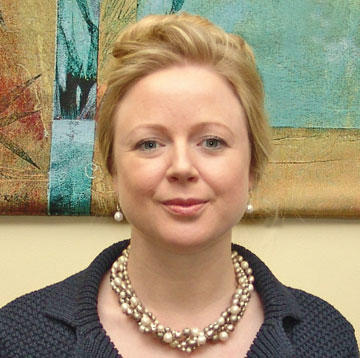Amy Berrington de González Appointed Chief of the Radiation Epidemiology Branch
, by DCEG Staff
by Jennifer K. Loukissas, M.P.P.
On December 19, 2014, Amy Berrington de González, D. Phil., was named Chief of the Radiation Epidemiology Branch (REB). Dr. Berrington is an internationally recognized expert in the field of cancer risk from medical radiation exposure. Her highly cited research into the potential cancer risks from CT scans has helped to inform clinical practice, as well as guidelines for cancer screening. Mindful of the critical balance of benefit and risk of diagnostic and treatment modalities involving radiation, Dr. Berrington’s work provides data to regulatory agencies on best practices for lowering doses and limiting the number of unnecessary CT scans, especially in children. She is the NCI Principal Investigator for the first study of children with these exposures; findings from the UK Pediatric CT Scans Study were published in The Lancet. In addition, Dr. Berrington continues to carefully monitor and study the potential risks from emerging radiotherapy technologies, including Intensity-Modulated Radiation Therapy and proton therapy, which have experienced a 7-fold increase in the number of centers in the U.S. over the last ten years. In 2013 she presented this work in an NIH Director’s Seminar "Medical radiation and cancer risk: assessing the price of progress" (video).
Dr. Berrington takes over from Martha Linet, M.D., M.P.H., who has served as Chief of REB since 2002. In addition to her many scientific contributions to the field of radiation epidemiology, Dr. Linet leaves as her legacy an outstanding, multidisciplinary team of investigators, including world-class radiation scientists whom she recruited, and the dosimetry unit, which has thrived during the last 12 years. “I am grateful to Martha for her extraordinary vision and leadership,” said Stephen J. Chanock, M.D., Director of DCEG. “REB studies the most pressing issues in radiation and cancer. These include medical radiation exposures, which Dr. Linet identified as a growing public health concern when she first became chief, exposures and risks from emerging radiologic technologies and from radiation disasters, and biomarkers and other features characterizing high-risk individuals in radiation-exposed populations.” Dr. Linet will remain a senior investigator in the branch.
Dr. Berrington has appointed Ruth Kleinerman, M.P.H., as Assistant Branch Chief. Ms. Kleinerman—an expert on second cancers following radiation therapy—will continue leading the large follow-up study of late effects in adult survivors of retinoblastoma, as well as her engagement on several other branch initiatives. She takes over from Kiyohiko Mabuchi, M.D., Dr.P.H., who during his tenure transformed the branch’s long-standing collaboration with the Japanese Atomic Bomb Survivors Study from involving just a few DCEG senior investigators to a growing number of junior researchers in the branch, and incorporated genetic/genomic studies to develop a better understanding of the biological basis of and genetic susceptibility for radiation-related cancer. Dr. Mabuchi will remain a senior scientist in the branch and head of the Chernobyl Research Unit.
REB includes world leaders in radiation epidemiology, statistics, and health physics, and is the largest radiation epidemiology research group in the world. The branch’s research touches the lives of every American, with investigations into the potential cancer risks from medical radiation exposure, to the study of second cancers resulting in part from cancer treatments, to exposure and risk from occupational and environmental radiation sources. REB’s interdisciplinary team carries out complex dose reconstruction efforts to project associated cancer risks for cleanup workers and populations living near the accident sites, such as the Chernobyl nuclear power plant, estimates global burden of cancer from nuclear weapons testing fallout, and assesses risks of cancer and other serious outcomes among technologists and physicians who use radiation in medical diagnostics and treatment. They also work in tandem with experts at the Radiation Effects Research Foundation in Japan to continue the long-term follow-up of survivors of the atomic bombs, which forms the basis for all low-dose radiation protection standards. To support this research, REB develops cutting edge methods and research tools—available for use by the broader scientific community—such as RadRat, an online calculator to estimate cancer risk from exposure to low-dose radiation. In addition, REB continues to monitor the possible cancer risks from cell phones—a matter of ongoing public concern—as well as other sources of non-ionizing radiation (ultraviolet radiation and power frequency magnetic fields), and operates a highly successful training program for junior investigators.
